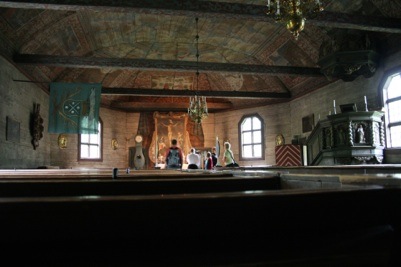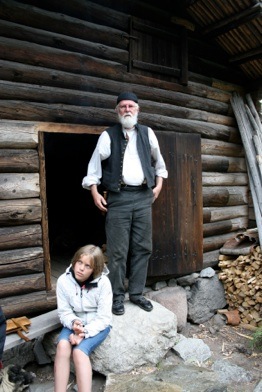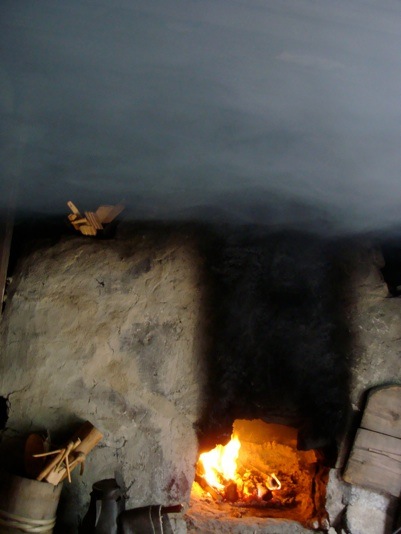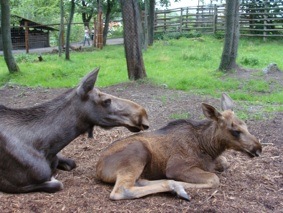Skansen is a huge park on one of the Stockholm islands. It is a combination of a zoo, a historical look back into life in Sweden in the past, and a performance space. On the same island is an amusement park (more about that in the next post). The rest of the island is mostly a park, with some houses, embassies and museums. The Wasa museum is in the same park.
For me (Chuck) the highlight of the visit was the Seglora church (pictured in the background in the lead picture).

The church was built in 1730 and was abandoned when a new stone church was built in 1903. This church is special to me because some of my relatives were christened (baptized) in that church before it was moved. And, Anna (one of my cousins was confirmed in the church where it sits now) and Eva (her sister) was married there.
We visited a Finnish settlement that came from the north of Sweden.

They lived in what is called a smoke cabin. The cabin has a fireplace which has no chimney. The smoke escapes into the cabin and forms a layer throughout the cabin. You must leave an opening for fresh air to come in and smoke to exit. Since there is no heat escaping out of the chimney, it is a very efficient way to heat a house. You can see that the entrance to the cabin is quite short. And, you cannot stand up in the cabin because the smoke layer is too low. Some pictures will illustrate how it works.

The open fireplace with the smoke layer. The scale is a little hard to see from the photo, but the opening is maybe 2 feet horizontally. The man told us that he had started the fire about 30 minutes previously and it was already quite warm in the cabin. They would apparently start the fire in the morning and let it burn for a couple of hours. Then they would go into the forest to work and the cabin would still have warmth when they returned at the end of the day.

A good picture of the smoke. You can just see the smoke exiting the door. You could feel some fresh air coming in the bottom of the door, but it wasn't a breeze-just air flow. You could put your hand into the smoke layer and disturb it.

A picture from the outside where you can see the smoke leaving the cabin. I suppose it is obvious by the pictures that we found this concept very interesting. I can't imagine it was a very healthy way to live (for your lungs), but I suppose there were other overriding considerations (like staying warm). One more interesting fact--they did not use the fire to cook. They built another fire next to a window for cooking. Given that the house was wood, I would imagine the chance of the cabin burning down must have been pretty high.
We saw lots of animals. The most impressive is the Swedish älg. The word translates as either elk or moose, but I think the Swedish animal is closer to a moose than an elk.

This is a picture of a young moose and a newborn. It is a bit hard to tell what the adults look like. They are huge animals, weighing up to 1000 pounds. They are hunted in Sweden and make for good eating.

